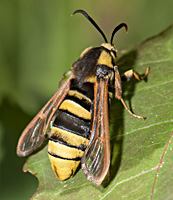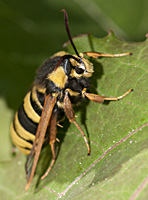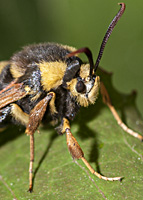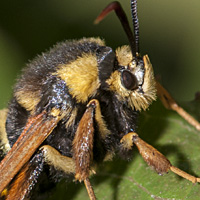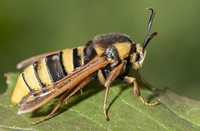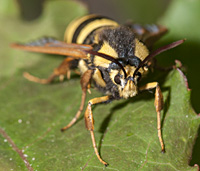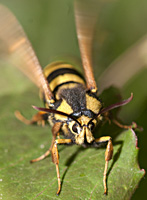[All pictures of garden wildlife on this page are thumbnails. Click on any thumbnail for a large format to be displayed.]

Hornet Moth (Sesia apiformis)
| Taxonomy | ||||||
|---|---|---|---|---|---|---|
| Kingdom: | Phylum: | Class: | Order: | Family: | Genus: | Species: |
| Animalia | Arthropoda | Insecta | Lepidoptera (Heterocera) | Sesiidae | Sesia | S. apiformis |
Hornet Moth is also known as Hornet Clearwing. Reaching the wingspan of 33-48mm this is an impressively huge moth. Its abdomen has yellow banding and the wings are transparent.
At the first glance it looks like a Hornet (Vespa crabro). Actually I almost ignored this insect because judging from the distance I assumed it was a hornet. Luckily I looked closer and I found out that it was not a member of any Wasp family at all. I quickly took several close-up pictures. But there was no need for me to hurry as the moth stayed on the same spot almost motionlessly just shaking with the wings from time to time. Mimicking the looks of a hornet gives the moth some protection from predators.
Although this insect is a moth it is active only during daytime.
Hornet Moth is quite common in Europe. In Britain it can be found in the southern parts of the country and is classified as 'Nationally Scarce B' there. The females lay their eggs at the base of poplar trees, the larvae feed on poplar wood, usually on Populus tremula, Populus nigra and Salix caprea. Only larvae can eat, once reaching the adults stage the insect stops eating. The moths come out in June and July. Hornet Moth be found on lower parts of the tree trunks in early to mid morning. It overwinters as a larva during a period of one or sometimes two seasons. Its total development period is 3-4 years.

© Copyright 1998-2024 gardensafari.net (Hania Berdys)

 English / engels
English / engels  Dutch / nederlands
Dutch / nederlands
